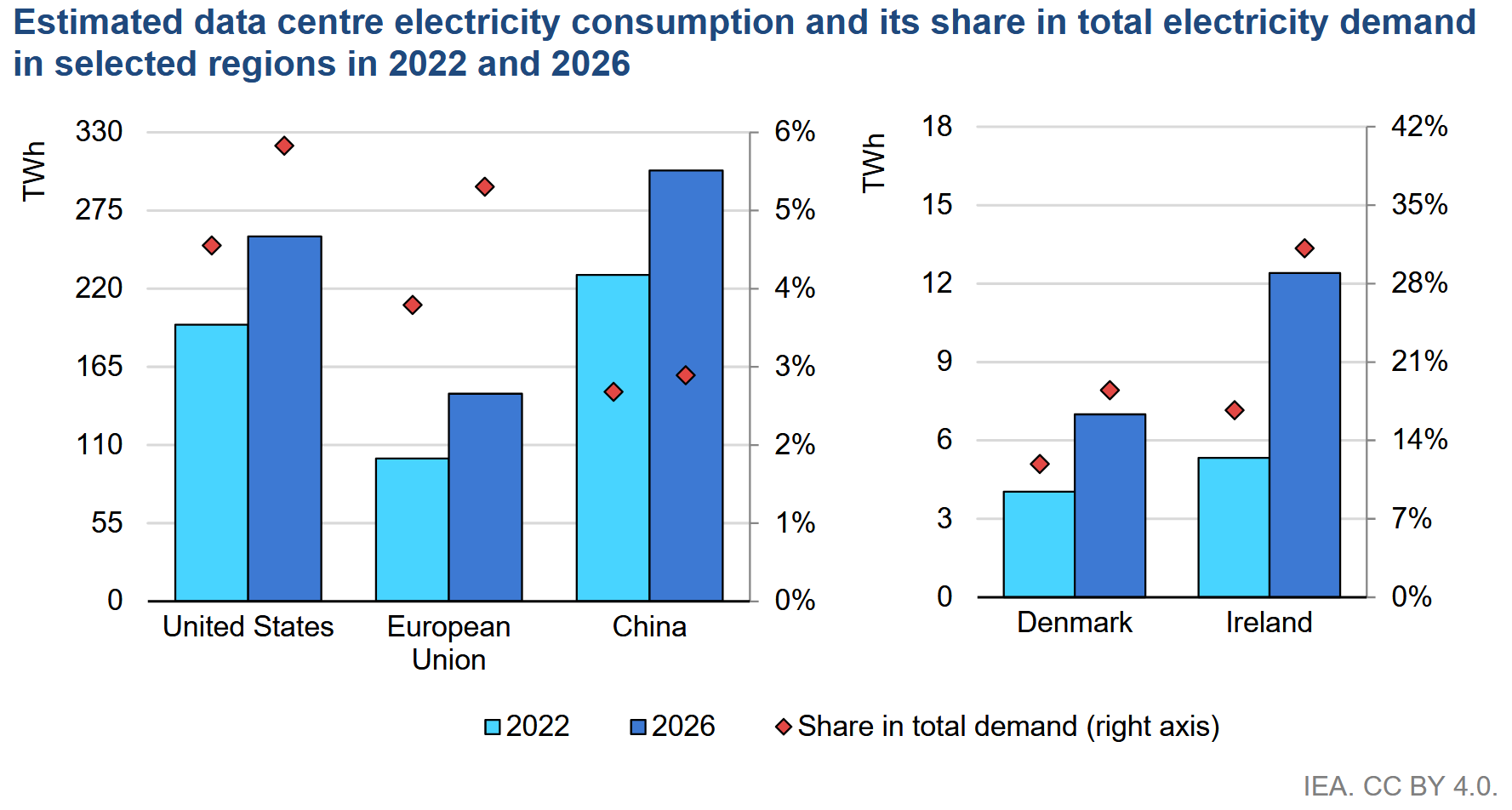Electricity 2024 - Analysis and forecast to 2026
Status:: 🟩
Links:: Energy Consumption & Carbon Emissions of Data Centers
Metadata
Authors:: IEA,
Title:: Electricity 2024 - Analysis and forecast to 2026
Date:: 2024
URL:: https://www.iea.org/reports/electricity-2024
DOI::
IEA. (2024). Electricity 2024—Analysis and forecast to 2026. IEA. https://www.iea.org/reports/electricity-2024
Electricity 2024 - Analysis and key findings. A report by the International Energy Agency.
Notes & Annotations
Color-coded highlighting system used for annotations
📑 Annotations (imported on 2024-03-19#21:39:04)
We estimate that data centres, cryptocurrencies, and artificial intelligence (AI) consumed about 460 TWh of electricity worldwide in 2022, almost 2% of total global electricity demand. Data centres are a critical part of the infrastructure that supports digitalisation along with the electricity infrastructure that powers them. The ever-growing quantity of digital data requires an expansion and evolution of data centres to process and store it. Electricity demand in data centres is mainly from two processes, with computing accounting for 40% of electricity demand of a data centre. Cooling requirements to achieve stable processing efficiency similarly makes up about another 40%. The remaining 20% comes from other associated IT equipment.

Notes: Includes traditional data centres, dedicated AI data centres, and cryptocurrency consumption; excludes demand from data transmission networks. The base case scenario has been used in the overall forecast in this report. Low and high case scenarios reflect the uncertainties in the pace of deployment and efficiency gains amid future technological developments. Sources: Joule (2023), de Vries, The growing energy footprint of AI; CCRI Indices (carbon-ratings.com); The Guardian, Use of AI to reduce data centre energy use; Motors in data centres; The Royal Society, The future of computing beyond Moore’s Law; Ireland Central Statistics Office, Data Centres electricity consumption 2022; and Danish Energy Agency, Denmark’s energy and climate outlook 2018.
In the European Union, data centre electricity consumption is estimated at slightly below 100 TWh in 2022, almost 4% of total EU electricity demand. Around 1 240 data centres were operating within Europe in 2022, with the majority concentrated in the financial centres of Frankfurt, London, Amsterdam, Paris, and Dublin.
In Europe, the data centre market in Ireland is developing rapidly as their electricity consumption grows along with new policies and initiatives. Electricity demand from data centres in Ireland was 5.3 TWh in 2022, representing 17% of the country's total electricity consumed.
The rapid expansion of the data centre sector and the elevated electricity demand can pose challenges for the electricity system. To safeguard the system’s stability and reliability, Ireland’s Commission for Regulation of Utilities published in late 2021 its decision on the new requirements applicable to new and ongoing data centre grid connection applications with three assessment criteria to determine if the connection offer can be made. First, the location of the data centre with respect to whether they are within a constrained region of the electricity system. Second, the ability of the data centre to bring onsite dispatchable generation and/or storage equivalent, at least, to their demand. Third, the ability of the data centre to provide flexibility in their demand by reducing it when requested by a system operator. For the third clause, data centre operators that offer their servers for hire will have to update their contracts to reflect the new regulations. These requirements showcase the local government’s inclination to grant connections to those operators that can make efficient use of the grid and incorporate renewable energy sources with a view of decarbonisation targets.

Note: Includes traditional data centres and dedicated AI data centres, excludes consumption from cryptocurrencies and data transmission networks. Sources: IEA, Data Centres and Data Transmission Networks; Lawrence Berkeley National Laboratory, United Stated Data Center Energy Usage Report; Ireland Central Statistics Office, Data Centres Metered Electricity Consumption 2022; Danish Energy Agency, Denmark’s Energy and Climate Outlook 2018; China’s State Council, Green data centres in focus; European Commission, Energy-efficient Cloud Computing Technologies and Policies for an Eco-friendly Cloud Market; Joule (2023), Alex de Vries, The growing energy footprint of artificial intelligence; and Crypto Carbon Ratings Institute, Indices.
Market trends, including the fast incorporation of AI into software programming across a variety of sectors, increase the overall electricity demand of data centres. Search tools like Google could see a tenfold increase of their electricity demand in the case of fully implementing AI in it. When comparing the average electricity demand of a typical Google search (0.3 Wh of electricity) to OpenAI’s ChatGPT (2.9 Wh per request), and considering 9 billion searches daily, this would require almost 10 TWh of additional electricity in a year.
In 2022, cryptocurrencies consumed about 110 TWh of electricity, accounting for 0.4% of the global annual electricity demand, as much as the Netherland’s total electricity consumption. In our base case, we anticipate that the electricity consumption of cryptocurrencies will increase by more than 40%, to around 160 TWh by 2026. Nevertheless, uncertainties remain for the pace of acceleration in cryptocurrency adoption and technology efficiency improvements. Ethereum, the second largest cryptocurrency by market cap, reduced its electricity demand by an amazing 99% in 2022 by changing its mining mechanism. By contrast, Bitcoin is estimated to have consumed 120 TWh by 2023, contributing to a total cryptocurrency electricity demand of 130 TWh. Challenges in reducing electricity consumption remain, as energy savings can be offset by increases in other energy consuming operations, such as other cryptocurrencies, even as some become more efficient.